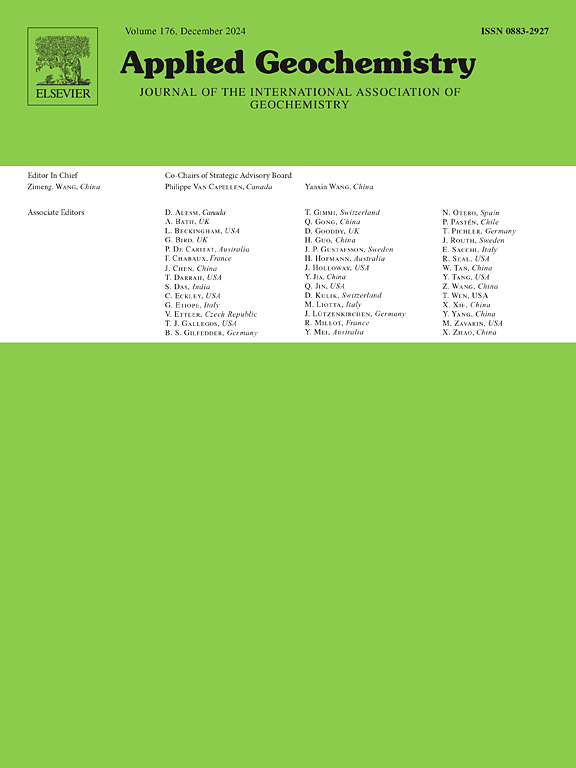Microbial influence on fast-growing iron oxyhydroxide-based speleothems in the acidic environment of Sitarjevec mine, Slovenia
IF 3.1
3区 地球科学
Q1 GEOCHEMISTRY & GEOPHYSICS
引用次数: 0
Abstract
This study investigates the mineralogical and morphological structure of iron oxide/hydroxide speleothems formed in the acid mine drainage (AMD) of the abandoned Sitarjevec mine near Litija in Slovenia (EU). These speleothems grow in the mine shafts under stable environmental conditions (complete darkness, a constant temperature of 10 °C and water with a pH value of 2.2–3.3), but show rapid growth of up to 5 cm/year. Using ion chromatography (IC) and carbon analysis, we detected phosphates, sulfates and carbon in the water dripping from the ceiling onto the stalagmite, indicating that bacteria can indeed colonize the surface of the stalagmite. SEM measurements provided evidence of the bacterial population and the morphology of the colored mineral (precipitate), closely resembling mineralogy of schwertmannite, which was formed in the mine water stored for several months under conditions normally found in the mine. Comparisons of the morphology, elemental composition and structure determined for different locations on the stalagmite (inner/outer part) with the morphological characteristics of the precipitate obtained by SEM/EDS measurements in combination with the analysis of XRD patterns and ATR-IR spectra showed the presence of bacteria and schwertmannite in the form of a hedge-hog particles. Analysis of the ATR-IR spectra of the outer part of the stalagmite and the mine water precipitate confirmed the presence of schwertmannite and a small amount of goethite. Goethite was predominantly present in the inner part of the stalagmite, but the ATR-IR spectra showed no evidence of schwertmannite or bacteria. From the XRD spectra, using the Rietveld method, it was confirmed that the outer part of the stalagmite contains mainly goethite, while the amount of schwertmannite did not exceed 17 wt%, which is also consistent with the results of the infrared spectra analysis. For the interior of the stalagmite, the Rietveld analysis showed no schwertmannite but only goethite.

斯洛文尼亚Sitarjevec矿酸性环境中微生物对快速生长的氧化铁类洞穴的影响
本文研究了斯洛文尼亚(EU) litja附近的Sitarjevec废弃矿山酸性排水(AMD)中形成的氧化铁/氢氧化物洞穴矿物学和形态结构。这些洞穴石斛生长在稳定的环境条件下(完全黑暗,恒温10°C, pH值为2.2-3.3的水),但生长速度快,可达5厘米/年。通过离子色谱(IC)和碳分析,我们检测了从天花板滴到石笋上的水中的磷酸盐、硫酸盐和碳,这表明细菌确实可以在石笋表面定居。扫描电镜测量提供了细菌种群和彩色矿物(沉淀物)形态的证据,与许氏锰矿的矿物学非常相似,许氏锰矿是在矿山正常条件下储存数月的矿水中形成的。将石笋不同部位(内/外)的形貌、元素组成和结构与SEM/EDS测量得到的沉淀物形态特征进行比较,结合XRD图谱和ATR-IR光谱分析,发现细菌和schwertmannite以对冲猪状颗粒的形式存在。对石笋外层和矿水沉淀物进行ATR-IR光谱分析,证实石笋中存在许氏菱铁矿和少量针铁矿。针铁矿主要存在于石笋的内部,但ATR-IR光谱未显示施韦特曼铁矿或细菌的证据。从XRD谱图上,利用Rietveld法确认石笋外层主要含有针铁矿,而施魏特曼铁矿的含量不超过17 wt%,这与红外光谱分析的结果也一致。对于石笋的内部,Rietveld的分析显示没有雪特曼铁矿,只有针铁矿。
本文章由计算机程序翻译,如有差异,请以英文原文为准。
求助全文
约1分钟内获得全文
求助全文
来源期刊

Applied Geochemistry
地学-地球化学与地球物理
CiteScore
6.10
自引率
8.80%
发文量
272
审稿时长
65 days
期刊介绍:
Applied Geochemistry is an international journal devoted to publication of original research papers, rapid research communications and selected review papers in geochemistry and urban geochemistry which have some practical application to an aspect of human endeavour, such as the preservation of the environment, health, waste disposal and the search for resources. Papers on applications of inorganic, organic and isotope geochemistry and geochemical processes are therefore welcome provided they meet the main criterion. Spatial and temporal monitoring case studies are only of interest to our international readership if they present new ideas of broad application.
Topics covered include: (1) Environmental geochemistry (including natural and anthropogenic aspects, and protection and remediation strategies); (2) Hydrogeochemistry (surface and groundwater); (3) Medical (urban) geochemistry; (4) The search for energy resources (in particular unconventional oil and gas or emerging metal resources); (5) Energy exploitation (in particular geothermal energy and CCS); (6) Upgrading of energy and mineral resources where there is a direct geochemical application; and (7) Waste disposal, including nuclear waste disposal.
 求助内容:
求助内容: 应助结果提醒方式:
应助结果提醒方式:


